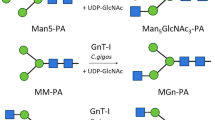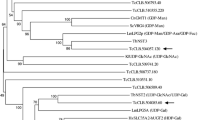Abstract
The α-N-acetylgalactosaminidase (α-NAGAL) is an exoglycosidase that selectively cleaves terminal α-linked N-acetylgalactosamines from a variety of sugar chains. A complementary DNA (cDNA) clone encoding a novel Clonorchis sinensis α-NAGAL (Cs-α-NAGAL) was identified in the expressed sequence tags database of the adult C. sinensis liver fluke. The complete coding sequence was 1,308 bp long and encoded a 436-residue protein. The selected glycosidase was manually curated as α-NAGAL (EC 3.2.1.49) based on a composite bioinformatics analysis including a search for orthologues, comparative structure modeling, and the generation of a phylogenetic tree. One orthologue of Cs-α-NAGAL was the Rattus norvegicus α-NAGAL (accession number: NP_001012120) that does not exist in C. sinensis. Cs-α-NAGAL belongs to the GH27 family and the GH-D clan. A phylogenetic analysis revealed that the GH27 family of Cs-α-NAGAL was distinct from GH31 and GH36 within the GH-D clan. The putative 3D structure of Cs-α-NAGAL was built using SWISS-MODEL with a Gallus gallus α-NAGAL template (PDB code 1ktb chain A); this model demonstrated the superimposition of a TIM barrel fold (α/β) structure and substrate binding pocket. Cs-α-NAGAL transcripts were detected in the adult worm and egg cDNA libraries of C. sinensis but not in the metacercaria. Recombinant Cs-α-NAGAL (rCs-α-NAGAL) was expressed in Escherichia coli, and the purified rCs-α-NAGAL was recognized specifically by the C. sinensis-infected human sera. This is the first report of an α-NAGAL protein in the Trematode class, suggesting that it is a potential diagnostic or vaccine candidate with strong antigenicity.






Similar content being viewed by others
References
Altschul SF, Gish W, Miller W, Myers EW, Lipman DJ (1990) Basic local alignment search tool. J Mol Biol 215(3):403–410
Bendtsen JD, Nielsen H, von Heijne G, Brunak S (2004) Improved prediction of signal peptides: signalP 3.0. J Mol Biol 340(4):783–795
Bouvard V et al (2009) A review of human carcinogens—Part B: biological agents. Lancet Oncol 10(4):321–322
Cantarel BL, Coutinho PM, Rancurel C, Bernard T, Lombard V, Henrissat B (2009) The carbohydrate-active EnZymes database (CAZy): an expert resource for Glycogenomics. Nucleic Acids Res 37(Database issue):D233–238
Cho PY, Kim TI, Whang SM, Hong SJ (2008) Gene expression profile of Clonorchis sinensis metacercariae. Parasitol Res 102(2):277–282
Choi D et al (2006) Cholangiocarcinoma and Clonorchis sinensis infection: a case–control study in Korea. J Hepatol 44(6):1066–1073
Davies MN, Flower DR (2007) Harnessing bioinformatics to discover new vaccines. Drug Discov Today 12(9–10):389–395
Dereeper A et al (2008) Phylogeny.fr: robust phylogenetic analysis for the non-specialist. Nucleic Acids Res 36(Web Server issue):W465–469
Emanuelsson O, Nielsen H, Brunak S, von Heijne G (2000) Predicting subcellular localization of proteins based on their N-terminal amino acid sequence. J Mol Biol 300(4):1005–1016
Fan Y et al (2011) Molecular cloning, expression, and immunolocalization of the NAD(+)-dependent glycerol 3-phosphate dehydrogenase (GPD) from Clonorchis sinensis. Parasitol Res 109(3):621–626
Fujino T, Ishii Y (1986) Comparative histochemical studies of glycosidase activity in some helminths. J Helminthol 60(1):1–13
Gan W et al (2010) Reverse vaccinology approach identify an Echinococcus granulosus tegumental membrane protein enolase as vaccine candidate. Parasitol Res 106(4):873–882
Gasteiger E et al. (2005) Protein identification and analysis tools on the ExPASy server. In: Walker JM (ed) The proteomics protocols handbook. Humana Press, New York, pp 571–607
Harun-Or-Rashid M et al (2010) Purification and characterization of alpha-N-acetylgalactosaminidases I and II from the starfish Asterina amurensis. Biosci Biotechnol Biochem 74(2):256–261
Henrissat B, Bairoch A (1996) Updating the sequence-based classification of glycosyl hydrolases. Biochem J 316(Pt 2):695–696
Henrissat B, Teeri TT, Warren RA (1998) A scheme for designating enzymes that hydrolyse the polysaccharides in the cell walls of plants. FEBS Lett 425(2):352–354
Hocker B, Claren J, Sterner R (2004) Mimicking enzyme evolution by generating new (beta/alpha)8-barrels from (beta/alpha)4-half-barrels. Proc Natl Acad Sci U S A 101(47):16448–16453
Irwin J et al (2004) Glycosidase activity in the excretory-secretory products of the liver fluke, Fasciola hepatica. Parasitology 129(04):465–472
Lang D, Thoma R, Henn-Sax M, Sterner R, Wilmanns M (2000) Structural evidence for evolution of the beta/alpha barrel scaffold by gene duplication and fusion. Science 289(5484):1546–1550
Larsen JE, Lund O, Nielsen M (2006) Improved method for predicting linear B-cell epitopes. Immunome Res 2:2
Lee MR et al (2011) The identification of antigenic proteins: 14-3-3 protein and propionyl-CoA carboxylase in Clonorchis sinensis. Mol Biochem Parasitol 182(1–2):1–6
Lun ZR et al (2005) Clonorchiasis: a key foodborne zoonosis in China. Lancet Infect Dis 5(1):31–41
Min XJ, Butler G, Storms R, Tsang A (2005) OrfPredictor: predicting protein-coding regions in EST-derived sequences. Nucleic Acids Res 33(Web Server issue):W677–680
Naumoff DG (2005) GH97 is a new family of glycoside hydrolases, which is related to the alpha-galactosidase superfamily. BMC Genomics 6:112
Oliveira MF et al (2000) Haemozoin in Schistosoma mansoni. Mol Biochem Parasitol 111(1):217–221
Pearl F et al (2005) The CATH Domain Structure Database and related resources Gene3D and DHS provide comprehensive domain family information for genome analysis. Nucleic Acids Res 33(Database issue):D247–251
Peterson ME, Chen F, Saven JG, Roos DS, Babbitt PC, Sali A (2009) Evolutionary constraints on structural similarity in orthologs and paralogs. Protein Sci 18(6):1306–1315
Quevillon E et al (2005) InterProScan: protein domains identifier. Nucleic Acids Res 33(Web Server issue):W116–120
Rappuoli R (2001) Reverse vaccinology, a genome-based approach to vaccine development. Vaccine 19(17–19):2688–2691
Sette A, Rappuoli R (2010) Reverse vaccinology: developing vaccines in the era of genomics. Immunity 33(4):530–541
Sterner R, Hocker B (2005) Catalytic versatility, stability, and evolution of the (beta/alpha)8-barrel enzyme fold. Chem Rev 105(11):4038–4055
Wu Y, Egerton G, Underwood AP, Sakuda S, Bianco AE (2001) Expression and secretion of a larval-specific chitinase (family 18 glycosyl hydrolase) by the infective stages of the parasitic nematode, Onchocerca volvulus. J Biol Chem 276(45):42557–42564
Yoo WG et al (2011) Developmental transcriptomic features of the carcinogenic liver fluke, Clonorchis sinensis. PLoS Negl Trop Dis 5(6):1–14
Acknowledgments
This work was supported by a grant from the Pathogenic Proteome Management Program of the National Institute of Health, Ministry of Health, and Welfare, Republic of Korea (NIH 48004847-300).
Competing interests
The authors have declared that no competing interests exist.
Author information
Authors and Affiliations
Corresponding authors
Additional information
Myoung-Ro Lee and Won Gi Yoo contributed equally to this study.
Rights and permissions
About this article
Cite this article
Lee, MR., Yoo, W.G., Kim, YJ. et al. Molecular characterization of an α-N-acetylgalactosaminidase from Clonorchis sinensis . Parasitol Res 111, 2149–2156 (2012). https://doi.org/10.1007/s00436-012-3063-y
Received:
Accepted:
Published:
Issue Date:
DOI: https://doi.org/10.1007/s00436-012-3063-y




